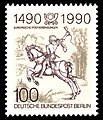Historical postal rate
The historical postal rate was a reconstruction of the former Dutch postal rate . The idea came up in 1988 on the occasion of the celebration of 500 years of the Post in 1990.
reconstruction
In the summer of 1988 the stagecoach owner Andreas Nemitz from Pähl (Upper Bavaria) asked the owner of the PR agency medien + kommunikation Harry P. Jost (Starnberg ) to develop a concept for a historic stagecoach trip between Innsbruck (Austria) and Mechelen (Belgium), which he wanted to offer to the then Federal Ministry for Post and Telecommunications on the occasion of the upcoming 500th anniversary celebration (1990). A few weeks later, the journalist Jost and Nemitz presented this concept to the Detecon company affiliated with the ministry . They were then commissioned not only to carry out the proposed historical stagecoach ride, but also to work out and organize a winter and a summer mail rider relay between Innsbruck and Mechelen, true to history. In the course of the research and in cooperation with the postal administrations in Germany, Austria and Belgium, the historical postal course was developed and Jost and Nemitz founded a GmbH for this purpose. For Germany, this GmbH, which was staffed by the PR agency, developed two four or five-jet stagecoach rallies at the request of the ministry, the destination of which was the then federal capital Bonn in early summer and Frankfurt am Main in late summer . In 1989 and 1990 you could book day trips or even complete rallies with carriages, overnight stays and full board via all post offices nationwide. a. started in Garmisch-Partenkirchen , Hof (Saale) , Glücksburg , Saarbrücken and Berlin . The guests received historical costumes at the respective starting locations and were made up and provided with wigs or beards by several make-up artists.
The big start of the first equestrian relay took place in Innsbruck during a live TV broadcast on January 1, 1990 at exactly 12 noon, which meant that the start of the traditional New Year's concert by the Vienna Philharmonic had to be postponed. After this first major event, which he successfully carried out, however, the managing director Andreas Nemitz withdrew from the company after his partner, Harry P. Jost, had inflated the cost range from originally approx. 2 million DM to 24 million DM as well as the technical level The competence of the Krefeld Kutschenkontor to be commissioned did not seem sufficient to him. From then on, Jost carried out the planning and organization alone with his team of around 30 permanent and over 60 freelance employees, with the hippological preparation and implementation, in which up to sixty horses and mail riders as well as several veterinarians were involved, in the responsibility of his wife Barbara Rieser (Alzheim / Eifel), mathematician and experienced trail rider, lay. She led the relay to their destination in Mechelen and Innsbruck in a historically correct manner in 5.5 days in the summer. In Mechelen even on a live broadcast on Belgian television to the minute and on a completely overcrowded place with over 5,000 visitors. Chaos threatened when, contrary to previous agreements, fireworks were started at the same moment. Fortunately without consequences.
After the summer relays, Ms. Rieser, as deputy head of operations, also took on joint responsibility for the stagecoach tours, the culmination of which took place on the Frankfurt Römer , which was also so overcrowded with several thousand visitors and a historical market that the stagecoaches, some of which were 12- and even 16- drove up in a spiffy, got stuck in the crowd. The guests of honor, Post Minister Christian Schwarz-Schilling and Gloria von Thurn und Taxis , therefore had to squeeze their way through the crowd from their stagecoach to the stage, where they were expected by the Postkurs team.
In 1991 the Historische Postkurs GmbH was dissolved again. The relay slips made during the relay rides and carried on the horses with the original stamps of all exchange stations were sent to the three postal museums in Germany, Austria and Belgium. The events of the historical postal course recorded a total of more than a hundred million circulation in the print media and over ten hours of broadcasting time on radio and television.
philately
The anniversary of 500 years of European postal connections was also used in the participating countries of Belgium, Germany (Bundespost, Bundespost Berlin and GDR) and Austria to issue a community postage stamp. The motif was Der Kleine Postreiter after an engraving by Albrecht Dürer .
Web links
literature
- Gottfried North: The "500 Years of Post" anniversary. Events and planning , in: Archive for German Postal History 1/1990, pp. 42–49.



